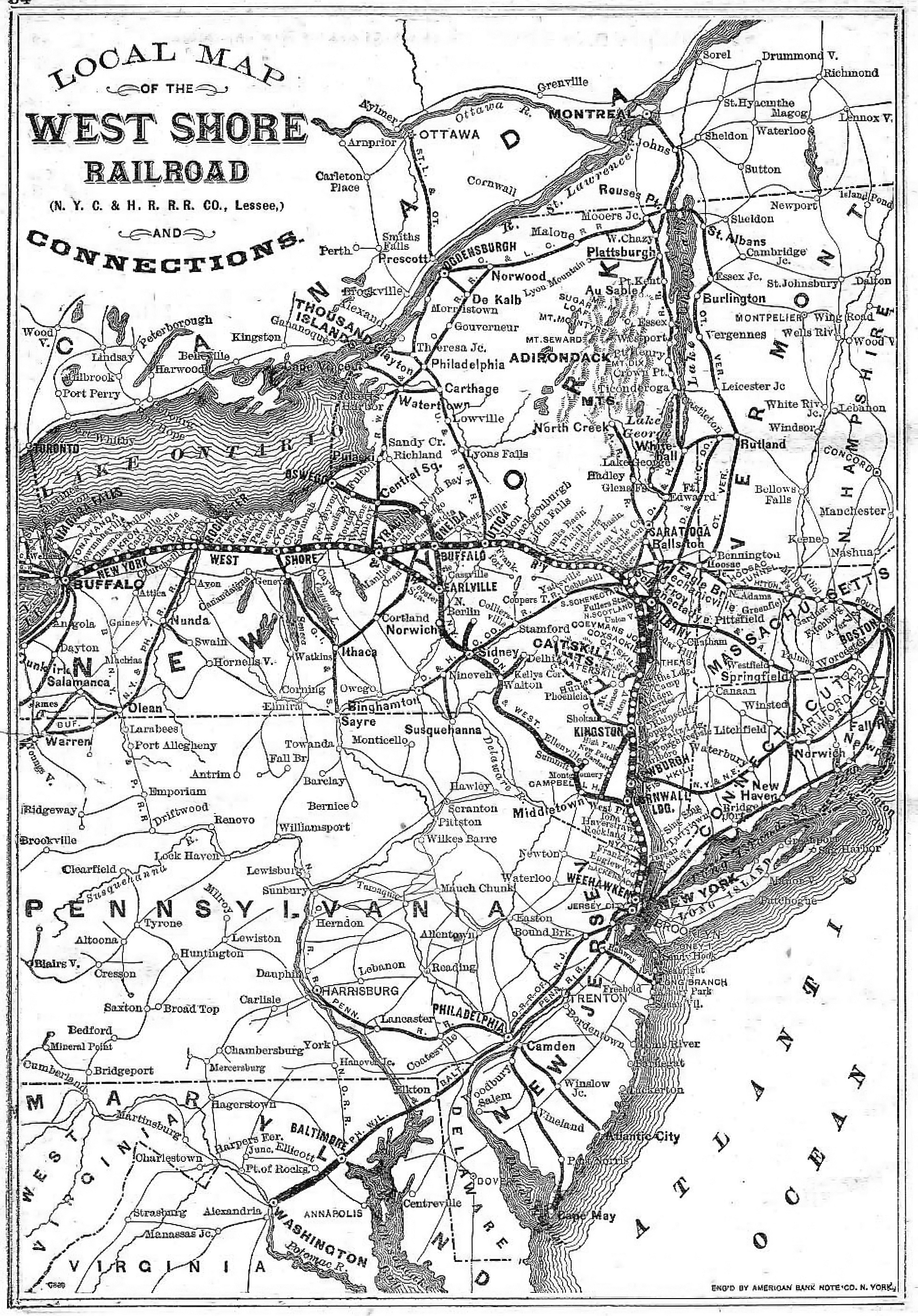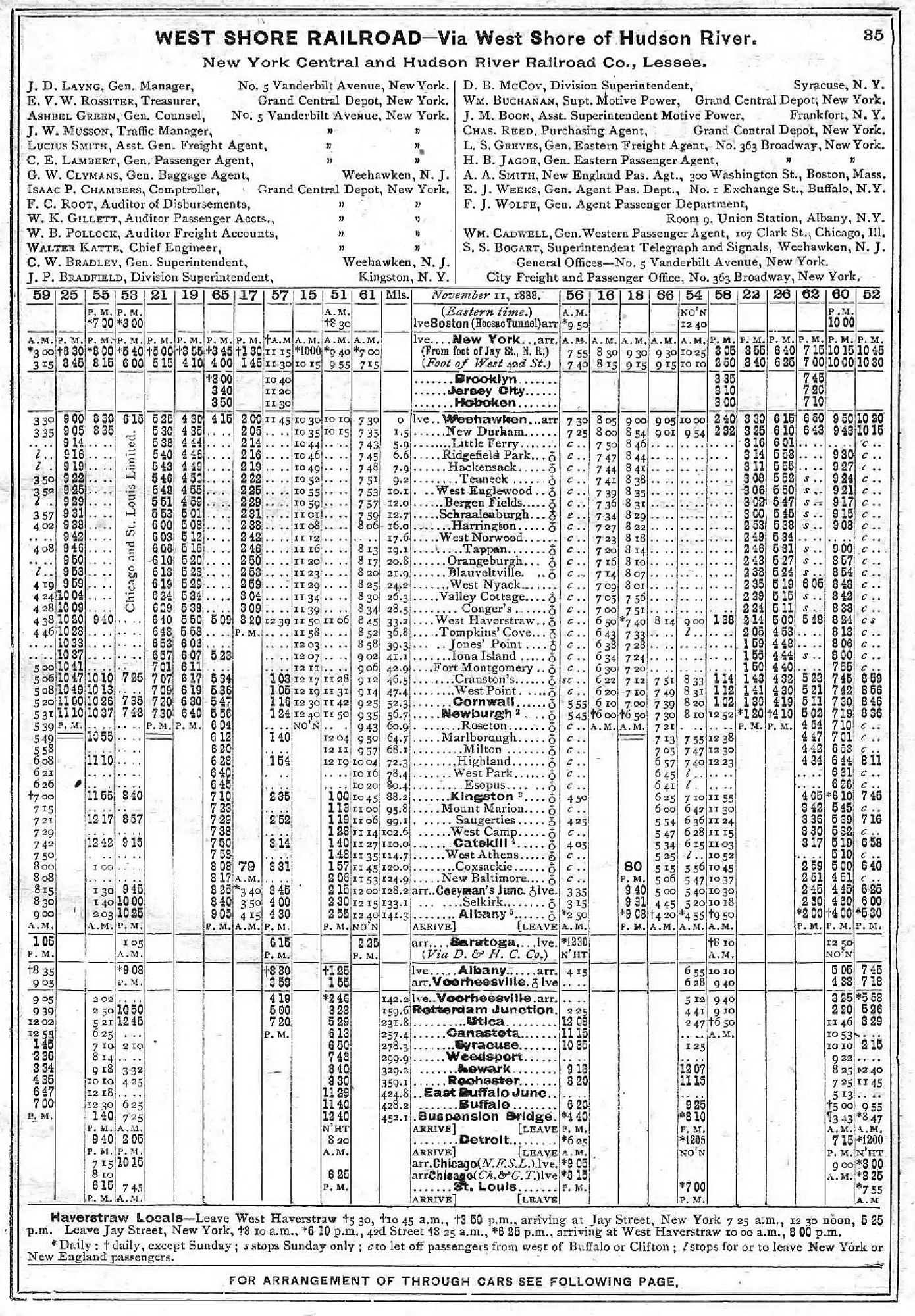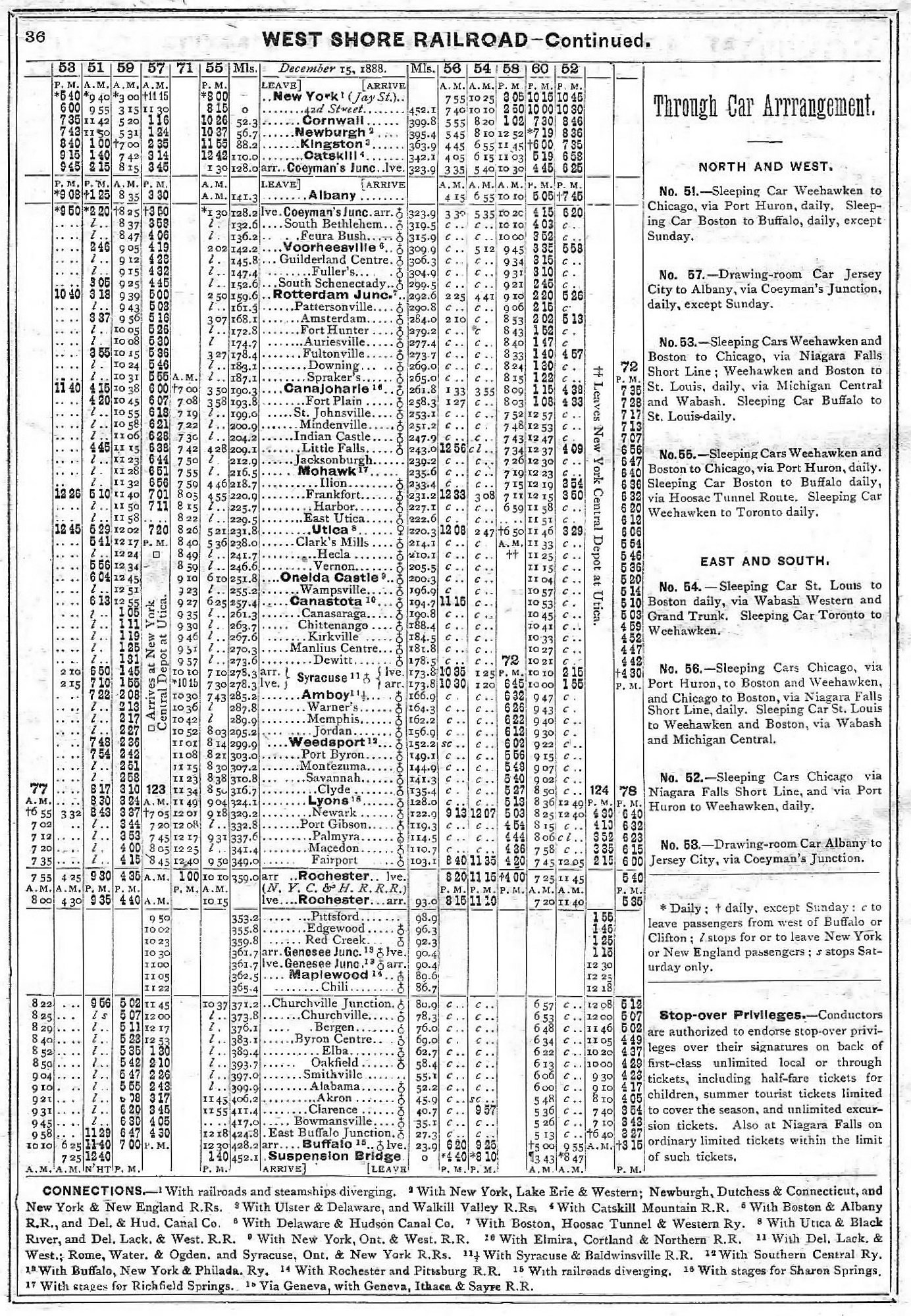West Shore Railroad: Map, History, Timetables
Published: June 30, 2024
By: Adam Burns
The West Shore Railroad, a once-prominent transportation artery in the northeastern United States, carries a rich history marked by competition, conflict, and eventual integration.
Spanning the western banks of the Hudson River and the shores of New Jersey, the West Shore played a pivotal role in shaping the region's transportation landscape during the late 19th and early 20th centuries.
On November 24, 1885 the New York Central acquired the New York, West Shore & Buffalo Railway, reorganizing it as the West Shore Railroad on December 5th. It remained a vital relief valve for the NYC and remains in service today.
System Map (1889)
Origins and Conceptualization
The story of the West Shore Railroad begins in the 1860s and 1870s with the burgeoning industrial growth in the United States. Railroads were becoming the lifeblood of commerce, creating opportunities for competitive ventures.
Visionaries and businessmen identified the western shore of the Hudson River as a promising route for a new railroad that could challenge the established dominance of the New York Central and Hudson River Railroad (NYC&HR).
The concept behind the West Shore was to provide a competitive alternative to the NYC&HR, specifically between Albany and New York City.
Its primary backers touted the potential for lower transportation costs and improved services, which could disrupt the existing rail monopoly in the region.
Formation and Early Development
The genesis of what was later dubbed the "White Elephant" Railroad began with the establishment of the Saratoga and Hudson River Railroad on April 16, 1864. Its early commencement in the spring of 1866 marked a brief period of independent operation before it was annexed by the formidable New York Central.
As it wound its way from Athens Junction near Schenectady, southeast and south along the west bank of the Hudson River towards Athens, New York, the line's future seemed promising. Ambitious expansion plans were conceived, including the acquisition of the Saratoga and Schenectady Railroad to extend its northern reach.
However, this optimism was short-lived. On September 9, 1867, less than two years after its inauguration, the Saratoga and Hudson River was absorbed into the NYC, rebranded as its Athens Branch. This acquisition marked the beginning of a storied chapter in the annals of railroad history.
The line faced its first major setback in 1876 when the terminal at Athens succumbed to a devastating fire. The railroad limped along for a few more years, but by the 1880s, intermittent operations signaled its slow decline. In 1888, the tracks were finally torn up, symbolizing the ultimate demise of the ill-fated line.
For much of its existence, the railroad earned the moniker "White Elephant" due to its perceived lack of utility and premature obsolescence. Yet, despite its troubled past, one enduring legacy remains.
The Brick Row Historic District in Athens, constructed in 1850 to house the workers of the ill-fated line, stands as a poignant reminder of this bygone era. This row of brick houses serves as the sole surviving structure associated with the ambitious, yet ultimately unfulfilled, "White Elephant" project.
Timetables (1889)
Completion and Early Operations
At the southern end was the Ridgefield Park Railroad, incorporated on April 4, 1867. This line was designed to function as a branch of the New Jersey Rail Road, diverging at Marion Junction and extending northward along the western flank of the New Jersey Palisades through Ridgefield Park, reaching the state border at Tappan, New York.
Once beyond the state line, the Rockland Central Railroad was chartered on May 23, 1870, to extend the route to Haverstraw, New York.
Building on this expansion, the Rockland Central Extension Railroad was incorporated on May 29, 1872, with plans to continue further north along the western shores of the Hudson River.
These two companies—the Rockland Central and the Rockland Central Extension—consolidated on July 29, 1872, under the unified name of the Rockland Central Railroad.
This period of mergers culminated on June 24, 1873, when the new Rockland Central Railroad joined forces with the Ridgefield Park Railroad to form the Jersey City and Albany Railroad.
The ambitious objective of this consolidated entity was to construct a comprehensive rail line stretching all the way from Jersey City to Albany, aiming to create a seamless connection along this strategically vital corridor.
The railroad venture encountered financial difficulties early on, leading to significant changes. The New York segment of the line was sold on September 28, 1877, and restructured on October 12, 1878, as the Jersey City and Albany Railway.
The New Jersey portion faced similar challenges, being sold on August 17, 1878, and reorganized under the same name. In January 1879, both sections merged to form a unified Jersey City and Albany Railway.
In a bid to further extend the line, the North River Railway was incorporated on April 3, 1880. This extension aimed to expand the route northward to Albany, with additional branches to Schenectady and connections to the New York, Ontario and Western Railway (O&W) at Cornwall, New York.
Subsequently, on May 5, 1881, the North River Railway merged with the Jersey City and Albany Railway, resulting in the formation of the North River Railroad.
This consolidation was intended to create a singular, continuous line from Jersey City to Albany, marking another ambitious step in the region's rail network development.
The Hudson River West Shore Railroad was established on February 16, 1867, followed by the incorporation of the West Shore Hudson River Railroad on October 28, 1867.
The latter absorbed the Hudson River West Shore Railroad on the same day, February 16, 1867, solidifying plans for a secondary rail line along the west shore of the Hudson River, extending from New Jersey to Albany.
The New York, West Shore and Chicago Railroad was incorporated on July 13, 1870, and it absorbed the West Shore Hudson River on July 21, 1877. This newly formed company ambitiously planned not only to reach Albany but to further extend westward along the southern bank of the Mohawk River all the way to Buffalo.
However, financial instability led to a sale and reorganization, resulting in the creation of the New York, West Shore and Buffalo Railway on February 18, 1880.
This new entity later integrated the North River Railroad on June 14, 1881, effectively consolidating all interests into one unified company. This strategic move aimed to control the entire route from New Jersey to Buffalo, marking a significant milestone in the expansion of the region's railroad network.
In 1883, the newly-formed company launched services between Newburgh and Jersey City, utilizing the Pennsylvania Railroad's station in Jersey City where passengers could conveniently transfer to ferries across the Hudson River.
A new alignment was constructed alongside the eastern side of the New York, Susquehanna and Western Railway (formerly the New Jersey Midland) reaching North Bergen. By 1886, operations extended to Weehawken Terminal through a newly-constructed tunnel under Bergen Hill, which had been developed over the three preceding years.
The company strategically leased the Athens Branch of the New York Central and Hudson River Railroad—originally the Saratoga and Hudson River Railroad—integrating it into their main line between Coxsackie and Fullers.
At Ravena, along the Athens Branch, the main line veered northwest toward Schenectady, while a new branch extended northward to Kenwood Junction, connecting to the Albany and Susquehanna Railroad in Albany. This comprehensive network posed an immediate competitive threat to the New York Central's longstanding monopoly.
In all, the West Shore stretched from Weehawken to Buffalo, covering a distance of approximately 428.2 miles. The railroad established key terminals in Weehawken, Albany, and Buffalo, positioning itself as a viable competitor in the regional transportation network.
Competition and Conflict
In 1881, the West Shore was envisioned as a critical link in an ambitious new transcontinental line stretching from New York to San Francisco. This integrated route was to utilize connections with the Nickel Plate Road, the Chicago, Milwaukee and St. Paul Railway, the Northern Pacific, and the Oregon Navigation Company.
However, this grand plan was soon thwarted. In 1882, William Henry Vanderbilt of the New York Central Railroad (NYC) acquired the Nickel Plate Road, effectively stifling the project. Subsequently, the NYC engaged in a relentless rate war against the New York, West Shore and Buffalo Railway.
This aggressive pricing strategy drove the WS into financial insolvency, leading to its bankruptcy as it could not endure the severe economic strain imposed by the NYC's tactics.
To eliminate the competion the NYC&HR simply acquired the NYWS&B on November 24, 1885, reorganizing it as the West Shore Railroad on December 5th that year.
Post-Acquisition Operations
Following the acquisition, the West Shore Railroad continued to operate as a subsidiary of the NYC&HR. It retained its name and identity but functioned under the broader management and operational framework of its new parent company.
The integration of the West Shore into the NYC&HR network facilitated improvements in service and efficiency. The consolidated railroad system offered better coordination of schedules, enhanced maintenance of infrastructure, and reduced redundancies, benefiting both passengers and freight customers.
Legacy and Modern Impact
Passenger services on the line ceased in 1958 for Albany and in 1959 for West Haverstraw, marking the end of direct New York Central service along the west side of the Hudson River.
The line subsequently became part of Penn Central in 1968 and was transferred to Conrail in 1976 following Penn Central's bankruptcy in 1970. When Conrail was divided between CSX Transportation and Norfolk Southern in 1999, the West Shore Railroad, along with most of the former New York Central lines, became part of the CSX network.
The route was rebranded as CSX's River Subdivision, which begins west of the Hudson Palisades at North Bergen Yard in Hudson County, New Jersey. From there, it travels north through Bergen County and Rockland County, New York, continuing along the west side of the Hudson River up to Selkirk Yard.
This yard provides connections to destinations both westward and eastward. South of North Bergen Yard, it links to the Northern Running Track, part of Conrail’s infrastructure. Additionally, the tunnel beneath the Palisades is now utilized by the Hudson Bergen Light Rail, which emerges at the Hudson Waterfront at Weehawken Port Imperial.
The story of the West Shore Railroad also offers valuable lessons about the challenges and opportunities inherent in the railroad industry. The fierce competition, financial struggles, and eventual consolidation underscore the complexities of establishing and maintaining a successful transportation enterprise in a highly competitive environment.
Conclusion
The West Shore Railroad's history is a testament to the ambition, innovation, and resilience of its founders and operators. From its origins as a competitive upstart challenging an established rail monopoly to its eventual integration into a broader network, the railroad played a significant role in shaping the transportation landscape of the northeastern United States.
Through its contributions to passenger and freight transport, the West Shore Railroad left an indelible mark on the region's economic and industrial development. Its legacy continues to be felt in the modern railways that traverse the same routes, carrying forward the spirit of innovation and progress that defined the railroad's early years.
In retrospect, the West Shore Railroad serves as a compelling chapter in the broader narrative of American railroad history, reflecting both the promise and perils of an industry that transformed the nation.
Recent Articles
-
Oregon Railroad Museums: A Complete Guide
Apr 25, 25 03:11 PM
With its rich tapestry of scenic landscapes and profound historical significance, Oregon possesses several railroad museums that offer insights into the state’s transportation heritage. -
North Carolina Railroad Museums: A Complete Guide
Apr 25, 25 02:56 PM
Today, several museums in North Caorlina preserve its illustrious past, offering visitors a glimpse into the world of railroads with artifacts, model trains, and historic locomotives. -
New Jersey Railroad Museums: A Complete Guide
Apr 25, 25 11:48 AM
New Jersey offers a fascinating glimpse into its railroad legacy through its well-preserved museums found throughout the state.




